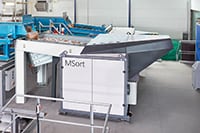Materials with the same visual appearance can now be precisely, quickly and cost-effectively sorted with the new MSort NIR (photo), which uses near-infrared (NIR) spectroscopy to physically analyze the material. At the beginning of the sorting process, the material flow passes by an NIR camera through a chute in free-fall. The camera allows the individual particles to be uniquely identified and the images to then be analyzed. Software analyzes the images and determines, in fractions of a second, whether a particle needs to be sorted out. The bulk material then passes by a strip of compressed-air nozzles, and the rejected particles are blown out. The sorting precision is said to be at least 95% in one sorting step. The MSort NIR type AP sorts bulk materials in the grain range of 10–50 mm with a throughput of up to 40 ton/h. This machine is especially suitable for separating plastics in glass recycling processes. — Allgaier Werke GmbH, Uhingen, Germany
